
Caliban is the second-largest retrograde irregular satellite of Uranus. It was discovered on 6 September 1997 by Brett J. Gladman, Philip D. Nicholson, Joseph A. Burns, and John J. Kavelaars using the 200-inch Hale telescope together with Sycorax and given the temporary designation S/1997 U 1.

Pasiphae, formerly spelled Pasiphaë, is a retrograde irregular satellite of Jupiter. It was discovered in 1908 by Philibert Jacques Melotte and later named after the mythological Pasiphaë, wife of Minos and mother of the Minotaur from Greek legend.

Setebos is one of the outermost retrograde irregular satellites of Uranus. It was discovered on 18 July 1999 by John J. Kavelaars et al. and provisionally designated S/1999 U 1.

Kale, also known as Jupiter XXXVII, is a retrograde irregular satellite of Jupiter. It was discovered in 2001 by astronomers Scott S. Sheppard, D. Jewitt, and J. Kleyna, and was originally designated as S/2001 J 8.

Sycorax is the largest irregular satellite of Uranus. Sycorax was discovered on 6 September 1997 by Brett J. Gladman, Philip D. Nicholson, Joseph A. Burns, and John J. Kavelaars using the 200-inch Hale telescope, together with Caliban, and given the temporary designation S/1997 U 2.
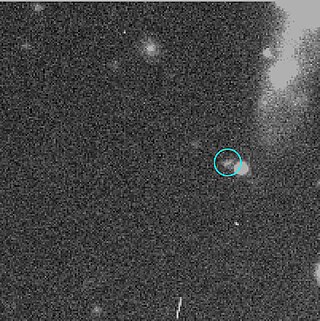
Prospero is a relatively small retrograde irregular satellite of Uranus discovered on 18 July 1999 by the astrophysicist Matthew Holman and his team, and given the provisional designation S/1999 U 3. Confirmed as Uranus XVIII it was named after the sorcerer Prospero in William Shakespeare's play The Tempest.

Harpalyke, also known as Jupiter XXII, is a retrograde irregular satellite of Jupiter. It was discovered by a team of astronomers from the University of Hawaii led by Scott S. Sheppard in 2000, and given the temporary designation S/2000 J 5. In August 2003, the moon was named after Harpalyke, the incestuous daughter of Clymenus, who in some accounts was also a lover of Zeus (Jupiter).
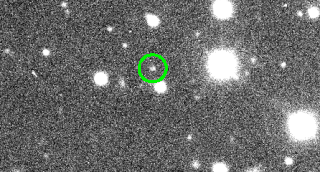
Hermippe, or Jupiter XXX, is a natural satellite of Jupiter. It was discovered concurrently with Eurydome by a team of astronomers from the Institute for Astronomy of the University of Hawaii led by David Jewitt and Scott S. Sheppard and Jan Kleyna in 2001, and given the temporary designation S/2001 J 3.

Iocaste, also known as Jupiter XXIV, is a retrograde irregular satellite of Jupiter. It was discovered by a team of astronomers from the University of Hawaii including: David C. Jewitt, Yanga R. Fernandez, and Eugene Magnier led by Scott S. Sheppard in 2000, and given the temporary designation S/2000 J 3.

Stephano is a retrograde irregular satellite of Uranus. It was discovered by Brett J. Gladman, et al. in 1999, and given the provisional designation S/1999 U 2.

Trinculo is a retrograde irregular satellite of Uranus. It was discovered by a group of astronomers led by Holman, et al. on 13 August 2001, and given the temporary designation S/2001 U 1.

Francisco is the innermost irregular satellite of Uranus.
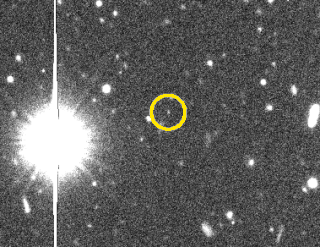
Margaret is the only known prograde irregular satellite of the moons of Uranus. It was discovered by Scott S. Sheppard, et al. in 2003 and given the provisional designation S/2003 U 3.

Halimede, or Neptune IX, is a retrograde irregular satellite of Neptune. It was discovered by Matthew J. Holman, John J. Kavelaars, Tommy Grav, Wesley C. Fraser and Dan Milisavljevic on August 14, 2002.
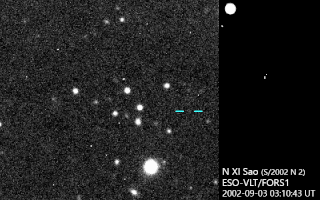
Sao is a prograde irregular satellite of Neptune. It was discovered by Matthew J. Holman et al. on August 14, 2002.
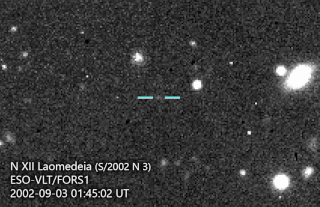
Laomedeia, also known as Neptune XII, is a prograde irregular satellite of Neptune. It was discovered by Matthew J. Holman, et al. on August 13, 2002. Before the announcement of its name on February 3, 2007, it was known as S/2002 N 3.

Neso, also known as Neptune XIII, is the outermost known natural satellite of Neptune. It is a retrograde irregular moon discovered by Matthew J. Holman, Brett J. Gladman, et al. on 14 August 2002, though it went unnoticed until 2003. Neso orbits Neptune at a distance of more than 48 million km, making it the most distant known moon of any planet. At apocenter, the satellite is more than 72 million km from Neptune. This distance exceeds Mercury's aphelion, which is approximately 70 million km from the Sun.

Psamathe, also known as Neptune X, is a retrograde irregular satellite of Neptune. It is named after Psamathe, one of the Nereids. Psamathe was discovered by Scott S. Sheppard and David C. Jewitt in 2003 using the 8.2 meter Subaru telescope. Before it was officially named on February 3, 2007, it was known by the provisional designation S/2003 N 1.
S/2004 S 7 is a natural satellite of Saturn. Its discovery was announced by Scott S. Sheppard, David C. Jewitt, Jan Kleyna, and Brian G. Marsden on 4 May 2005 from observations taken between 12 December 2004 and 8 March 2005.
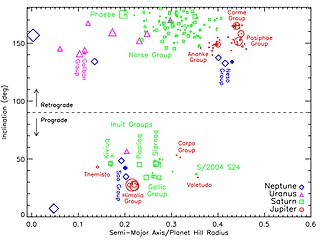
In astronomy, an irregular moon, irregular satellite, or irregular natural satellite is a natural satellite following a distant, inclined, and often highly elliptical and retrograde orbit. They have been captured by their parent planet, unlike regular satellites, which formed in orbit around them. Irregular moons have a stable orbit, unlike temporary satellites which often have similarly irregular orbits but will eventually depart. The term does not refer to shape; Triton, for example, is a round moon but is considered irregular due to its orbit and origins.























